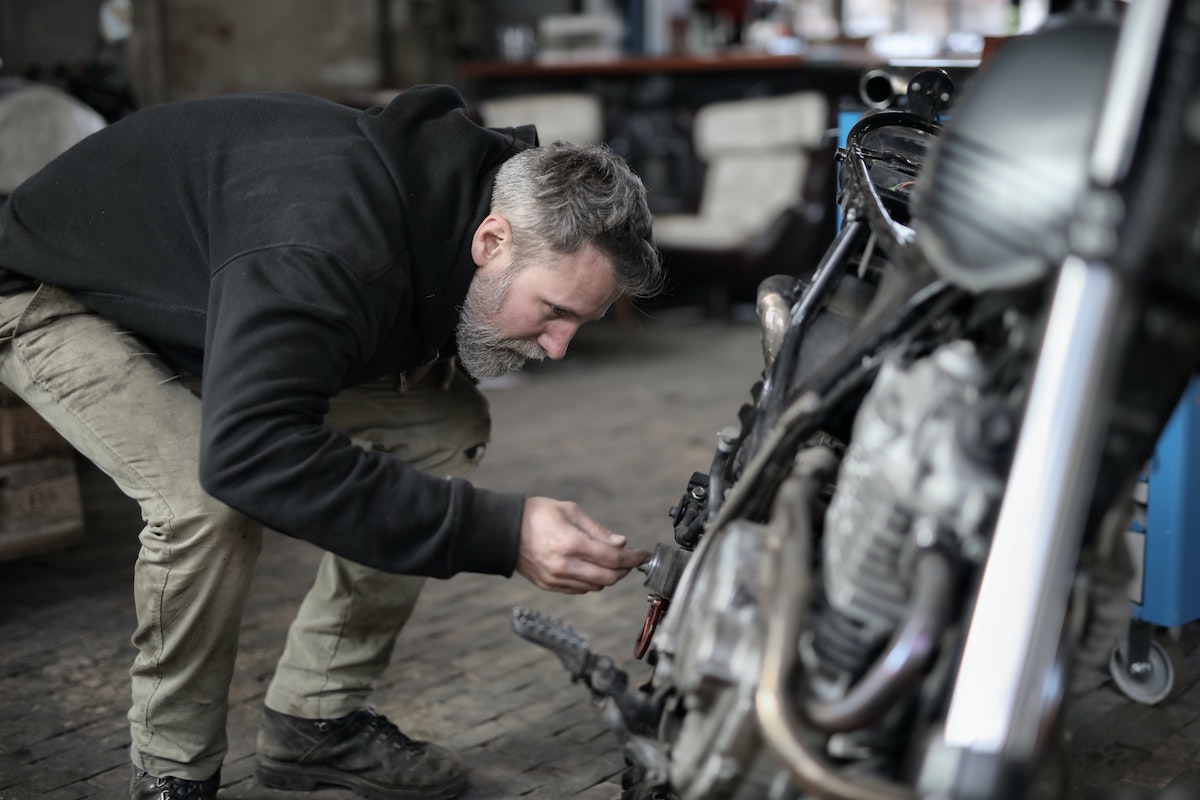How to organize your garage – or not!
As I’ve mentioned in recent columns, I just moved. I was extremely excited about the new accommodations for my bikes, trailer, tools, gear and other moto-miscellany. My present garage is much larger than the most recent one and has an adjoining workshop connected to a finished basement. I’d envisioned this seemingly vast combined space as capable of swallowing everything from my old garage and dungeon-esque basement with lots of room to spare—enough for a couple of PWCs I’d been keeping at a friend’s house and maybe even a car! (I’ve never had room for one of those before.)
I was utterly delusional.
 It’s become abundantly clear the PWCs will have to remain in exile with their enormous trailer. A small car will barely fit in the garage, but only if I keep my electric trials bike in the downstairs den (at least there’s no oil to drip or gas fumes to smell). That machine isn’t much larger than a mountain bike, so that tells you how cramped things are. The garage is packed so tightly, access to most anything requires temporarily rearranging other stuff, Tetris-style. I hadn’t taken into consideration how the bulky built-in shelving would interfere with my exploitation of the raw square-footage, and it turns out the neatly rectangular basement workshop’s capacity is far less than what my ancient catacombs held in their multitude of convoluted recesses. I’ve jettisoned a ridiculously excessive accumulation of parts and scraps that had seemed potentially useful during the hoarding process, but making the new facility functional still requires serious organizational effort. No doubt another trip to the dump is in my future. I’ve set up a half-dozen garages in the past, but none posed this much challenge, either because they were even more spacious, or I had less to squeeze into them.
It’s become abundantly clear the PWCs will have to remain in exile with their enormous trailer. A small car will barely fit in the garage, but only if I keep my electric trials bike in the downstairs den (at least there’s no oil to drip or gas fumes to smell). That machine isn’t much larger than a mountain bike, so that tells you how cramped things are. The garage is packed so tightly, access to most anything requires temporarily rearranging other stuff, Tetris-style. I hadn’t taken into consideration how the bulky built-in shelving would interfere with my exploitation of the raw square-footage, and it turns out the neatly rectangular basement workshop’s capacity is far less than what my ancient catacombs held in their multitude of convoluted recesses. I’ve jettisoned a ridiculously excessive accumulation of parts and scraps that had seemed potentially useful during the hoarding process, but making the new facility functional still requires serious organizational effort. No doubt another trip to the dump is in my future. I’ve set up a half-dozen garages in the past, but none posed this much challenge, either because they were even more spacious, or I had less to squeeze into them.
In addition to all the above, the move was executed in a chaotic rush due to some peculiar timing constraints. In the past, I’ve had the luxury of a more leisurely pace and could thoughtfully map out where everything would go before transporting it. I’d have my shelving, racks, workbench and other infrastructure in place first, ready to provide familiar homes for the granular contents of my garage as I carried it over. This time, I hauled it all as one jumbled mess; contents and infrastructure had to be moved as quickly as possible altogether and ended up piled floor-to-ceiling with little or no forethought regarding their eventual arrangement. When the time finally came to start organizing, most of it had to be dragged out onto the driveway just to create enough open space to assemble shelves and position large items along the walls.
“How to Organize Your Garage” is Episode 7 of the podcast and features Mark responding to a listener’s comment about technology possibly alienating us from our motorcycles.
The Ride Inside with Mark Barnes is brought to you by the BMW MOA Foundation.
The books mentioned in the Q&A are:
- Zen and the Art of Motorcycle Maintenance, by Robert Pirsig
- Shop Class as Soulcraft and Why We Drive, by Matthew Crawford
- Fundamental Electrical Troubleshooting, by Dan Sullivan
While this situation has been frustrating and disorienting, it’s made me think about the process of organization in new ways. When I could lay out my garage ahead of installing everything, I’d carefully consider what would fit where, maybe with the help of some graph paper and cut-out scale models of the major pieces to be arranged. I’d also think about workflow, so things would be stored near the areas where they’d be used, and interference with ingress/egress would be minimized. This amounted to a rather abstract, cerebral puzzle, enjoyable in itself. Such planning would be accompanied by excitement focused on whatever advantages the new space held over the previous one. However, in each case much of my speculative imagining would prove inaccurate.
Yes, cabinet X did fit in the designated space, but I hadn’t allowed enough room for its doors to swing open easily with me standing there. The lugs I’d put in the floor for my tire-change stand had it located awkwardly close to my trailer’s tongue, so making a complete revolution around its circumference required stepping over the tongue or moving the trailer. A bunch of tools and supplies were shelved conveniently next to my workbench, but I mainly used them in the other bay, where I wound up doing most of my bike disassembly. In the midsummer heat, I had no good place to put my fan. The list goes on. Substantial revisions to the original organization would always be required as I actually lived and worked in the space and discovered the discrepancies between my early fantasies and subsequent realities.
Another type of discrepancy has become apparent, too. Having now made considerable progress imposing organization on my current space, my reflexes are stuck in the old-world order. I decided it makes the most sense to put toolbox A here, but I keep reaching for it over there because that’s where I’m used to having it. In wondering which system—logic or tradition—should take priority, I’ve realized every organizational schema I’ve ended up with over the years has involved a great deal of idiosyncratic, completely illogical arrangement. Especially where there is no clear functional advantage to a certain setup, I’ve defaulted to a fundamentally emotional orientation. It’s the difference between putting all my old record albums in alphabetical order, so anyone could find a particular title efficiently, versus grouping them by nostalgic themes (e.g. this dozen are associated with this past romance), so I can find a particular title most efficiently.
Hence, toolboxes A, B and C always go in that order, left to right, because I got them in that order. Same goes for the boxes of take-off parts and spares for my current collection of bikes—oldest bike’s stuff goes on the bottom shelf, newest on the top. What about those half-dozen tires awaiting trial? Of course, the ones with the coolest looking tread patterns go at the most visible end of the lineup. The dirt gear cabinets go to the right of the street gear cabinets because that’s how they’ve always been since I needed more than one cabinet for my gear. Solvents go on the top shelf of supplies, with brake and clutch servicing items next because that’s how a revered personal mentor kept his. Automotive fluids get relegated to the bottom supply shelf because (obviously!) they’re automotive, and not motorcycle-related.

Even when it involves a functional disadvantage, I might still opt for an emotionally driven arrangement. My rolling tool cart collected a slew of stickers on its right side years ago when I was heavily into KTM dirt bikes and rode with a like-minded gang; said cart was tucked against the right end of my workbench. Now, even though I’d have more room to open its drawers if it faced north in its current corner, I’ve got that cart facing east so I can still see those stickers and enjoy the fond memories they evoke.
Organization is a more organic process than I had in mind while bemoaning the seemingly disastrous disorder resulting from my hurried move. Lacking the (overestimated) benefit of a comprehensively thought-out plan, I’ve been forced to use plain old trial-and-error in coming up with an arrangement. While it feels less efficient to move all my stuff back and forth, I just might be sorting out problems sooner rather than later. In the process of moving the actual things into place, I can spot conflicts I might not have thought of during imaginative planning. Proactively logical ordering is always limited by failures of anticipation. In an odd way, memories and imagination—the bases of anticipation—often require external prompts to take shape. You may only recall the treehouse from your childhood when you see the old tree where it had been. I may only realize the need for a wide berth around my tire-change stand when my shin touches my trailer’s tongue and I’m reminded of a more painful impact years ago.
 Revisions will no doubt still be necessary later when I perform tasks in this space for the first time, but I expect fewer of them. Organizing my garage in this decidedly illogical way seems more pragmatic, and I’m automatically putting things where they feel right, even if it’s not entirely rational. All my garage/workshop areas in the past have eventually evolved into exactly this kind of organization. I might as well let it happen from the start. Even with that attitude, I expect this will be a multi-year process wherein layers of organization accumulate, like the formation of a pearl, based on repetition (that’s where something has always been), happenstance (oh, look—it fits right there!) and other alogical factors. Just now I realized an old bike rack I no longer use as such is perfect for holding a cylindrical light in a crucial spot. There’s absolutely no way I’d have thought of that without serendipitously holding both items in my hands at the same time. The organization that develops over time depends on many such fortuitous revelations—not carefully logical planning.
Revisions will no doubt still be necessary later when I perform tasks in this space for the first time, but I expect fewer of them. Organizing my garage in this decidedly illogical way seems more pragmatic, and I’m automatically putting things where they feel right, even if it’s not entirely rational. All my garage/workshop areas in the past have eventually evolved into exactly this kind of organization. I might as well let it happen from the start. Even with that attitude, I expect this will be a multi-year process wherein layers of organization accumulate, like the formation of a pearl, based on repetition (that’s where something has always been), happenstance (oh, look—it fits right there!) and other alogical factors. Just now I realized an old bike rack I no longer use as such is perfect for holding a cylindrical light in a crucial spot. There’s absolutely no way I’d have thought of that without serendipitously holding both items in my hands at the same time. The organization that develops over time depends on many such fortuitous revelations—not carefully logical planning.
When it first occurred to me I might write about the ordeal of tackling the chaos in my garage, I thought I’d try to establish some universally applicable ideals for setting up a proper wrenching environment. What I’ve realized is the ideal arrangement for any particular individual is so personal few, if any, overarching principles can be applied.
The book on garage Feng Shui is nothing but blank pages. You’re on your own.
Mark Barnes is a clinical psychologist and motojournalist. To read more of his writings, check out his book Why We Ride: A Psychologist Explains the Motorcyclist’s Mind and the Love Affair Between Rider, Bike and Road, currently available in paperback through Amazon and other retailers.



